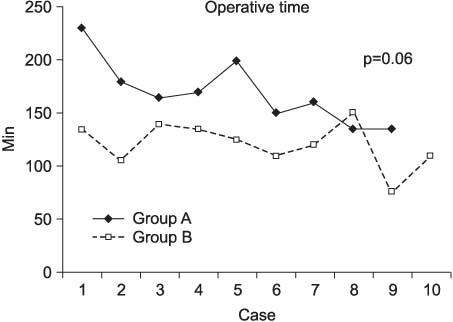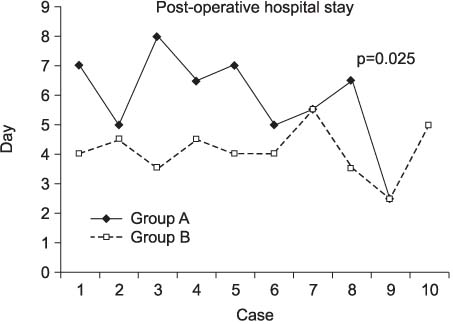Korean J Urol.
2006 Nov;47(11):1204-1209. 10.4111/kju.2006.47.11.1204.
The Safety and Efficacy of Laparoscopic Transperitoneal Adrenalectomy in Patients with Pheochromocytoma
- Affiliations
-
- 1Department of Urology, Dong-A University School of Medicine, Busan, Korea.
- KMID: 2294280
- DOI: http://doi.org/10.4111/kju.2006.47.11.1204
Abstract
- Purpose
Pheochromocytomas are relatively uncommon tumors, the operative resection of which presents clear medical and technical challenges. We report our experience of a laparoscopic transperitoneal adrenalectomy in a series of 22 patients with a pheochromocytoma. In a comparison of the early (A) and late (B) surgery groups, the "learning curve" and efficacy and safety of a laparoscopic transperitoneal adrenalectomy for a pheochromocytoma were evaluated.
Materials and Methods
Between January 1998 and August 2005, 22 patients with a pheochromocytoma underwent a laparoscopic transperitoneal adrenalectomy (LTA). Patients were divided into groups A (early surgery group, LTA between January 1998 and January 2002) and B (late surgery group, LTA February 2002 and August 2005). The operative time, intraoperative blood loss, mean time to oral intake, mean postoperative hospital stay and intraoperative hypertensive crises were analyzed retrospectively.
Results
The mean operative times were 169.4 and 122.5 min in the groups A and B (p=0.003), with mean blood losses of 149.4 and 129.5cc, respectively (p=0.045). The mean postoperative hospital stays were 6.5 and 4.4 days in groups A and B, respectively (p=0.015). Intraoperative hypertensive crises occurred in two and one patient in groups A and B, respectively. With a mean follow-up of 34 months, the regression of symptoms and control of blood pressure were obtained in all patients, without additional treatment.
Conclusions
In group B, the mean operative time, intraoperative blood loss and the mean postoperative hospital stay were shortened. In our experience, an adrenal pheochromocytoma can be treated safely and effectively using a laparoscopic transperitoneal approach.
Keyword
MeSH Terms
Figure
Reference
-
1. Sung GT, Gill IS. Laparoscopic adrenalectomy. Semin Laparosc Surg. 2000. 7:211–222.2. Kim HH, Kim GH, Sung GT. Laparoscopic adrenalectomy for pheochromocytoma: comparison with conventional open adrenalectomy. J Endourol. 2004. 18:251–255.3. Gagner M, Lacroix A, Prinz RA, Bolte E, Albala D, Potvin C, et al. Early experience with laparoscopic approach for adrenalectomy. Surgery. 1993. 114:1120–1124.4. Stoker ME, Patwardhan N, Maini BS. Laparoscopic adrenal surgery. Surg Endosc. 1995. 9:387–390.5. Suzuki K, Kageyama S, Ueda D, Ushiyama T, Kawabe K, Tajima A, et al. Laparoscopic adrenalectomy: clinical experience with 12 cases. J Urol. 1993. 150:1099–1102.6. Prinz RA. Laparoscopic adrenalectomy. J Am Coll Surg. 1996. 183:71–73.7. Assalia A, Gagner M. Laparoscopic adrenalectomy. Br J Surg. 2004. 91:1259–1274.8. Gill IS, Clayman RV, McDougall EM. Advances in urological laparoscopy. J Urol. 1995. 154:1275–1294.9. Cheah WK, Clark OH, Horn JK, Siperstein AE, Duh QY. Laparoscopic adrenalectomy for pheochromocytoma. World J Surg. 2002. 26:1048–1051.10. Gonzalez R, Smith CD, McClusky DA 3rd, Ramaswamy A, Branum GD, Hunter JG, et al. Laparoscopic approach reduces likelihood of perioperative complications in patients undergoing adrenalectomy. Am Surg. 2004. 70:668–674.11. Kercher KW, Park A, Matthews BD, Rolband G, Sing RF, Heniford BT. Laparoscopic adrenalectomy for pheochromocytoma. Surg Endosc. 2002. 16:100–102.12. Inabnet WB, Pitre J, Bernard D, Chapuis Y. Comparison of the hemodynamic parameters of open and laparoscopic adrenalectomy for pheochromocytoma. Word J Surg. 2000. 24:574–578.13. Gagner M, Breton G, Pharand D, Pomp A. Is laparoscopic adrenalectomy indicated for pheochromocytomas? Surgery. 1996. 120:1076–1079.14. Fernandez-Cruz L, Taura P, Saenz A, Benarroch G, Sabater L. Laparoscopic approach to pheochromocytoma: hemodynamic changes and catecholamine secretion. World J Surg. 1996. 20:762–768.15. Tanaka M, Tokuda N, Koga H, Kimoto Y, Naito S. Laparoscopic adrenalectomy for pheochromocytoma: comparison with open adrenalectomy and comparison of laparoscopic surgery for pheochromocytoma versus other adrenal tumors. J Endourol. 2000. 14:427–431.16. Flavio Rocha M, Faramarizi-Rogues R, Tauzin-Fin P, Vallee V, Leitao de Vasconcelos PR, Ballanger P. Laparoscopic surgery for pheochromocytoma. Eur Urol. 2004. 45:226–232.17. Gockel I, Vetter G, Heintz A, Junginger T. Endoscopic adrenalectomy for pheochromocytoma: difference between the transperitoneal and retroperitoneal approaches in terms of the operative course. Surg Endosc. 2005. 19:1086–1092.18. John H, Ziegler H, Hauri D, Jaeger P. Pheochromocytomas: can malignant potential be predicted? Urology. 1999. 53:679–683.19. Niemann U, Hiller W, Behrend M. 25 years experience of the surgical treatment of pheochromocytoma. Eur J Surg. 2002. 168:716–719.20. Goldstein RE, O'Neill JA Jr, Holcomb GW 3rd, Morgan WM 3rd, Neblett WW 3rd, Oates JA, et al. Clinical experience over 48 years with pheochromocytoma. Ann Surg. 1999. 229:755–764.21. Li ML, Fitzgerald PA, Price DC, Norton JA. Iatrogenic pheochromocytomatosis: a previously unreported result of laparoscopic adrenalectomy. Surgery. 2001. 130:1072–1077.22. Hobart MG, Gill IS, Schweizer D, Sung GT, Bravo EL. Laparoscopic adrenalectomy for large-volume (> or = 5cm) adrenal masses. J Endourol. 2000. 14:149–154.23. Scott HW Jr, Halter SA. Oncologic aspects of pheochromocytoma: the importance of follow-up. Surgery. 1984. 96:1061–1066.24. Vargas HI, Kavoussi LR, Bartlett DL, Wagner JR, Venzon DJ, Fraker DL, et al. Laparoscopic adrenalectomy: a new standard of care. Urology. 1997. 49:673–678.
- Full Text Links
- Actions
-
Cited
- CITED
-
- Close
- Share
- Similar articles
-
- Posterior Retroperitoneoscopic Adrenalectomy for Large Adrenal Pheochromocytoma: A Case Report
- Learning Curve and Clinicopathologic Analysis in Transperitoneal Laparoscopic Adrenalectomy; Performed by a Single Young Surgeon with No Experience of Open Adrenalectomy
- Early Detection and Successful Laparoscopic Adrenalectomy for Pheochromocytoma in Pregnancy; A Case Report
- Laparoscopic Adrenalectomy: Lessons Learned from 111 Consecutive Cases
- Transperitoneal Laparoscopic Adrenalectomy: A Single Surgeon Experience




